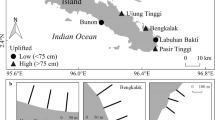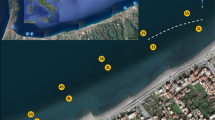Abstract
Organisms boring into intertidal consolidated sediments generate bioerosion. It is generally unknown, however, whether they can significantly contribute to coastline retraction. In this paper, we describe endolithic communities and estimate bioerosion and physical erosion rates at three southwestern Atlantic intertidal sites (37, 38, and 42°S; Argentina). In the northernmost site, we have also analyzed spatial variation in species richness and abundance as a function of height within the tidal slope, orientation of the rock surface in relation to breaking waves (i.e., facing or not), and rock hardness. The number of species and the combined abundance of individuals from the different species were larger at the low intertidal level but did not differ between surface orientations. The density of chemically boring organisms increased with increasing rock hardness and calcium carbonate content. In contrast, no correlation was found between rock hardness and the abundance of organisms that bore by mechanical means. Endolithic community composition and bioerosion rates differed among the three sites, the latter being higher at the site with the softer substrate. Bioerosion estimates were two orders of magnitude lower than physical erosion estimates at each site. The bivalve Lithophaga patagonica was the species that contributed the most to bioerosion at all these locations. While results suggest that bioerosion contributes little to overall coastal erosion at the three study sites, boring organisms might still facilitate physical erosion by weakening the rock either via chemical or mechanical means. Besides, their apparently inconsequential direct action as bioeroders can have positive consequences for biodiversity via increased habitat complexity.






Similar content being viewed by others
References
Adami ML, Tablado A, Gappa JL (2004) Spatial and temporal variability in intertidal assemblages dominated by the mussel Brachidontes rodriguezii (d`Orbigny, 1846). Hydrobiologia 520:49–59
Adami ML, Tablado A, Sodor MA (2008) Population dynamics of the intertidal mytilid Brachidontes rodriguezii (Bivalvia) on a rocky shore. Thalassas 24(1):19–25
Amor A (1994) Ecology of Pherusa sp. (Polychaeta, Flabelligeridae) In: Dauvin JC, Launier L, Reish DJ (eds) Actes de la 4ème Conférence internationale des Polychèttes. Mém Mus natn Hist nat Paris 162:339–346
Amor A, López Armengol MF, Iñiguez Rodriguez AM, Traversa LP (1991) Intertidal endolithic fauna and its relationship to the mineralogical, physical and chemical characteristics of the substrate. Mar Biol 111:271–280
Ansell AD, Nair NB (1969) A comparative study of bivalves which bore mainly by mechanical means. Am Zool 9:857–868
Arribas LP, Bagur M, Klein E, Penchaszadeh PE, Palomo MG (2013) Geographic distribution of two mussel species and associated assemblages along the northern Argentinean coast. Aquat Biol 18:91–103
Badano EI, Jones CG, Cavieres LA, Wright JP (2006) Assessing impacts of ecosystem engineers on community organization: a general approach illustrated by effects of a high-Andean cushion plant. Oikos 115:369–385
Bagur M, Richardson CA, Gutiérrez JL, Arribas LP, Doldan MS, Palomo MG (2013) Age, growth and mortality in four populations of the boring bivalve Lithophaga patagonica from Argentina. J Sea Res 81:49–56
Bartol IK, Mann R, Luckenbach M (1999) Growth and mortality of oysters (Crassostrea virginica) on constructed intertidal reefs: effects of tidal height and substrate level. J Exp Mar Biol Ecol 237:157–184
Beesley PL, Ross GJB, Glasby CJ (2000) Polychaetes and Allies: the southern synthesis. CSIRO Publishing, Melbourne
Cantera JR, Orozco C, Londoño-Cruz E, Toro-Farmer G (2003) Abundance and distribution patterns of infaunal associates and macroborers of the branched coral (Pocillopora damicornis) in Gorgona Island (Eastern Tropical Pacific). Bull Mar Sci 72:207–219
Carver RE (1971) Procedures in sedimentary petrology. Wiley, New York
Chao A (1984) Non-parametric estimation of the number of classes in a population. Scand J Stat 11:265–270
Colwell RK (2005) EstimateS: statistical estimation of species richness and shared species from samples Ver 7.5. http://purl.oclc.org/estimates. Accessed 14 July 2012
Colwell RK, Coddington J (1994) Estimating terrestrial biodiversity through extrapolation. Philos Trans R Soc Lond 1311:101–118
Colwell RK, Mao CX, Chang J (2004) Interpolating, extrapolating, and comparing incidence-based species accumulation curves. Ecology 85:2717–2727
Cutler EB, Cutler NJ (1988) A revision of the genus Themiste (Sipuncula). Proc Biol Soc Wash 101(4):741–766
Donn TF, Boardman MR (1988) Bioerosion of rocky carbonate coastlines on Andros Island, Bahamas. J Coastal Res 4(3):381–394
Elías R, Rivero MS (2009) First new Dodecaceria (Polychaeta: Cirratulidae) species from the SW Atlantic (38°S–57°W, Argentina). Rev Biol Mar Oceanogr 44(1):131–136
Elías R, Palacios JR, Rivero MS, Vallarino EA (2005) Short-term responses to sewage discharge and storms of subtidal sand-bottom macrozoobenthic assemblages off Mar del Plata City, Argentina (SW Atlantic). J Sea Res 53:231–242
Evans JW (1968a) The role of Penitella penita (Conrad 1837) (Family Pholadidae) as eroders along the Pacific coast of North America. Ecology 49:156–159
Evans JW (1968b) The effect of rock hardness and other factors on the shape of the burrow of the rock boring clam Penitella penita. Palaeogeogr Palaeoclimatol Palaeoecol 4:271–278
Galinou-Mitsoudi S, Sinis AI (1997) Population dynamics of the date mussel, Lithophaga lithophaga (L., 1758) (Bivalvia: Mytilidae), in the Evoikos Gulf (Greece). Helgoländer Meeresun 51:137–154
Gotelli NJ, Colwell RK (2001) Quantifying biodiversity: procedures and pitfalls in the measurement and comparison of species richness. Ecol Lett 4:379–391
Gutiérrez JL, Palomo MG, Iribarne OO (2000) Patterns of abundance and seasonality of polychaetes sheltering in southwestern Atlantic estuarine epibenthic shell beds. Bull Mar Sci 67:165–174
Gutiérrez JL, Jones CG, Strayer DL, Iribarne OO (2003) Mollusks as ecosystem engineers: the role of shell production in aquatic habitats. Oikos 101:79–90
Herrmann M, Alfaya JEF, Lepore ML, Penchaszadeh PE, Laudien J (2009) Reproductive cycle and gonad development of the Northern Argentinean Mesodesma mactroides (Bivalvia: Mesodesmatidae). Helgoland Mar Res 63:207–218
Hunter WR (1949) The structure and behaviour of Hiatella gallicana (Lamarck) and H. arctica (L.), with special reference to the boring habit. Proc R Soc Edinb B 63:271–289
Hutchings PA (1986) Biological destruction of coral reefs, a review. Coral Reefs 4:239–252
Isla FI, Bértola GR (2005) Litoral bonaerense. In: de Barrio RE, Etcheverry RO, Caballé MF, Llambías E (eds) Geología y Recursos Minerales de la Provincia de Buenos Aires. Relatorio del XVI Congreso Geológico Argentino, La Plata, pp 265–276
Isla FI, Bértola GR, Farenga MO, Serra SB, Cortizo LC (1998) Villa Gesell: un desequilibrio sedimentario inducido por fijaciones de médanos. Rev Asoc Argent Sedimentol 5(1):41–51
Jones CG, Lawton JH, Shachak M (1994) Organisms as ecosystem engineers. Oikos 69:373–386
Kiene WE, Hutchings PA (1994) Bioerosion experiments at Lizard Island, Great Barrier Reef. Coral Reefs 13:91–98
Kleemann KH (1973) Der Gesteinsabbau durch Ätzmuscheln an Kalkküsten (Erosion of Limestone Coasts by Date Mussels). Oecologia 13:377–395
Kleemann KH (1996) Biocorrosion by bivalves. Mar Ecol 17:145–158
Kleemann K (2005) The silent sentinels—The Demise of Tropical Coral Reefs, Chapter 5. http://biophysics.sbg.ac.at/reefs/reefs.htm Accessed 20 Feb 2010
Kokot RR (2004) Erosión en la costa patagónica por cambio climático. Rev Asoc Geol Argent 59(4):715–726
Kokot RR, Codignotto JO, Elissondo M (2004) Vulnerabilidad al ascenso del nivel del mar en la costa de la provincia de Río Negro. Rev Asoc Geol Argent 59(3):477–487
Leonard G, Levine JM, Schmidt P, Bertness MD (1998) Flow-driven variation in intertidal community structure in a Maine estuary. Ecology 79(4):1395–1411
Levinton JS (2009) Marine biology: function, biodiversity, ecology, 3rd edn. Oxford University Press, New York
Little C, Kitching JA (1996) The biology of rocky shores (biology of habitats). Oxford University Press, New York
Londoño-Cruz E, Cantera JR, Toro-Farmer G, Orozco C (2003) Internal bioerosion by macroborers in Pocillophora spp. in the tropical eastern Pacific. Mar Ecol Prog Ser 265:289–295
López RA, Marcomini SC (2005) Obras de defensa en costas de dunas de la provincia de Buenos Aires. Rev Geol Apl Ing Ambiente 21:157–165
MacGeachy JK, Stearn CW (1976) Boring by macro-organisms in the coral Montastrea annularis on Barbados Reefs. Int Revue Ges Hydrobiol 61:715–745
Marcomini SC, López RA (1999) Alteración de la dinámica costera por explotación de arena de playa, partido de General Alvarado, provincia de Buenos Aires. Rev Asoc Argent Sedimentol 6:1–18
Marcomini SC, López RA, Spinoglio A (2007) Uso de la morfología costera como geoindicador de susceptibilidad a la erosión en costas cohesivas, Necochea, Buenos Aires. Rev Asoc Geol Argent 62:396–404
Mikkelsen PM, Bieler R (2008) Seashells of Southern Florida: living marine mollusks of the Florida Keys and adjacent regions, Bivalves. Princeton University Press, Princeton
Neumann AC (1966) Observation on coastal erosion in Bermuda and measurement of the boring rate of sponge Cliona lampa. Limnol Oceanogr 11:92–108
Pastorino G, Bagur M (2011) The genus Sphenia Turton, 1822 (Bivalvia: Myidae) from shallow waters of Argentina. Malacologia 54:431–435
Penchaszadeh PE, Olivier SR (1975) Ecología de una población de ‘berberecho’ (Donax hanleyanus) en Villa Gesell, Argentina. Malacologia 15:133–146
Pinn EH, Richardson CA, Thompson RC, Hawkins SJ (2005) Burrow morphology, biometry, age and growth of piddocks (Mollusca: Bivalvia: Pholadidae) on the south coast of England. Mar Biol 147:943–953
Pinn EH, Thompson RC, Hawkins SJ (2008) Piddocks (Mollusca: Bivalvia: Pholadidae) increase topographical complexity and species diversity in the intertidal. Mar Ecol Prog Ser 355:173–182
Scasso RA, del Río CJ (1987) Ambientes de sedimentación y proveniencia de la secuencia marina del Terciario Superior de la región de península Valdés. Rev Asoc Geol Argent 42:291–321
Schillizzi R, Gelos EM, Spagnuolo J (2004) Procesos de retracción de los acantilados patagónicos entre la desembocadura de los ríos Negro y Chubut, Argentina. Rev Asoc Argent Sedimentol 11(1):17–26
Stearley RF, Ekdale AA (1989) Modern marine bioerosion by macroinvertebrates, Northern Gulf of California. Palaios 4:453–467
Turner RD (1954) The family Pholadidae in the western Atlantic and the eastern Pacific, Part I: Pholadinae. Johnsonia 3:1–64
Williams JA, Margolis SV (1974) Sipunculid burrows in coral reefs: evidence for chemical and mechanical excavation. Pac Sci 28(4):357–359
Yonge CM (1951) Observations on Sphenia binghami Turton. J Mar Biol Assoc UK 30:387–392
Yonge CM (1963) Rock-boring organisms. In: Sognnaes R (ed) Mechanisms of Hard Tissue Destruction. Am Assoc Adv Sci 75:1-24
Acknowledgments
We thank Guido Pastorino for help in species identification, Carlos Sánchez Antelo and Sabrina Soria for field assistance, and Eleonor Tietze, Diana Montemayor, Jesús Nuñez and Emiliano Ocampo for housing during field trips. We also thank the staff at Estación Hidrobiológica de Puerto Quequén and the municipal camping site in Puerto Pirámides. The research presented here was partly funded by a CONICET grant (Consejo Nacional de Investigaciones Científicas y Técnicas; PIP 112-200801-00732) to MGP and JLG. MB and LPA were supported by CONICET doctoral fellowships. The bivalves in the protected area of Puerto Pirámides were collected with permission from the Chubut Province (Secretaría de Turismo y Áreas Protegidas de Chubut). This is a contribution to the program of GrIETA.
Author information
Authors and Affiliations
Corresponding author
Additional information
Communicated by M. Huettel.
Rights and permissions
About this article
Cite this article
Bagur, M., Gutiérrez, J.L., Arribas, L.P. et al. Endolithic invertebrate communities and bioerosion rates in southwestern Atlantic intertidal consolidated sediments. Mar Biol 161, 2279–2292 (2014). https://doi.org/10.1007/s00227-014-2505-8
Received:
Accepted:
Published:
Issue Date:
DOI: https://doi.org/10.1007/s00227-014-2505-8




